The Thermal Data
A total of 6 tests were conducted at 1.0 GPM with fan speeds of 750 rpm, 1300 rpm and 1850 rpm being run in Push Only and Push/Pull. All inclusive this testing takes between 40 – 50 hours of logging time (plus processing the data) to get the results that are presented.
Below is the final data results gathered from at least 5 data logging runs at the flow rate and fan rpm combination. The most stable 15 minute period from each logging run was used and then averaged with the other runs to obtain the data for the table below. A total of 16 temperature sensors were used in the thermal test chamber (8 air in, 2 air out, 3 water in, 3 water out). Each sensor takes a reading every second and is logged via a CrystalFontz unit.
The data in the table below is the averaged results of the logging runs which has then been used to create all the plots and tables there-after.
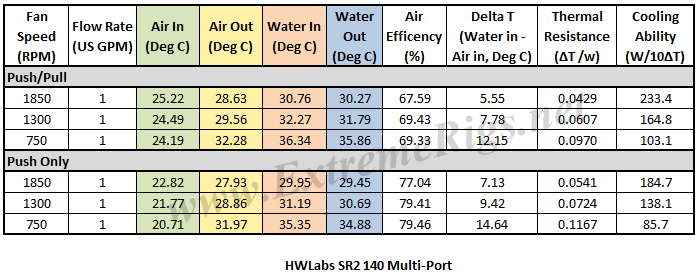 The performance metric of critical importance is the delta between the warm coolant temperature in and the cold ambient air temperature going in to the radiator. Given that the system is well insulated and in equilibrium and we know the heat input to the system then we can also calculate a very important number. That number is the amount of power required to raise the coolant temperature by set amount. That amount is typically 1C or 10C. The latter is a more useful reference point.
The performance metric of critical importance is the delta between the warm coolant temperature in and the cold ambient air temperature going in to the radiator. Given that the system is well insulated and in equilibrium and we know the heat input to the system then we can also calculate a very important number. That number is the amount of power required to raise the coolant temperature by set amount. That amount is typically 1C or 10C. The latter is a more useful reference point.
Let’s take a look at the Delta T results from the tests. Note that the extrapolation of the curve is much more sensitive to error than in between the tested range.
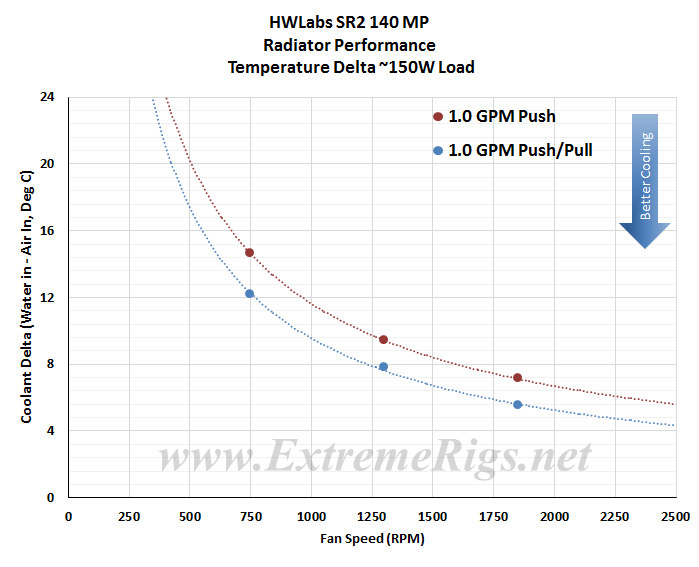 I was not too concerned about the actual delta numbers, more so the trend pattern, and as we should expect, the deltas come down significantly as the fan speed is increased.
I was not too concerned about the actual delta numbers, more so the trend pattern, and as we should expect, the deltas come down significantly as the fan speed is increased.
Delta T results (as above) are not always helpful when thinking about how many radiators you would need to cool your system. Instead it’s more useful to know the metric of W/delta C as plotted below. It tells us how many watts are dissipated by the radiator when the coolant rises 10C above ambient temperatures. (W/10 Delta T):
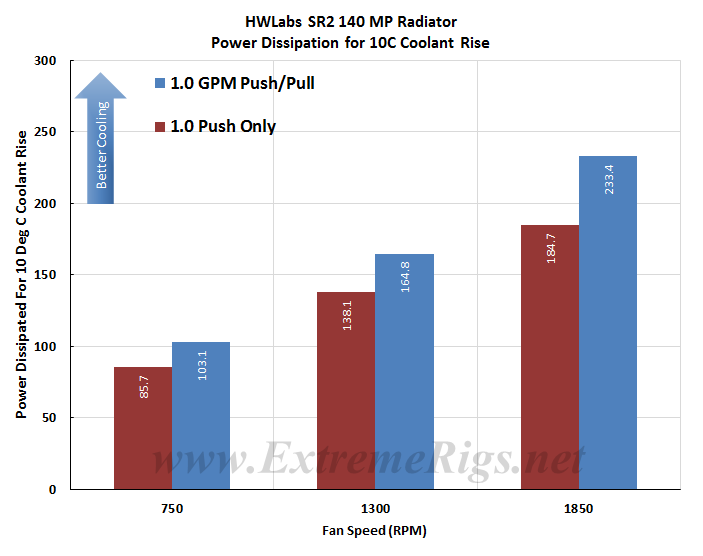 We can clearly see more separation between Push Only and Push/Pull at 1850 rpm, indicating that the thick core is able to effectively use the extra air flow that Push/Pull offers. At both 750 rpm and 1300 rpm the difference was ~16.5% while at 1850 rpm the difference increases to ~21%. Surprisingly then, the SR2 140 MP efficiency continues to get better with increased air flow.
We can clearly see more separation between Push Only and Push/Pull at 1850 rpm, indicating that the thick core is able to effectively use the extra air flow that Push/Pull offers. At both 750 rpm and 1300 rpm the difference was ~16.5% while at 1850 rpm the difference increases to ~21%. Surprisingly then, the SR2 140 MP efficiency continues to get better with increased air flow.
This same data can now be plotted on a chart so that an end user can interpolate their own fan speed. Note again that the extrapolation of the curve is much more sensitive to error than in between the tested range.
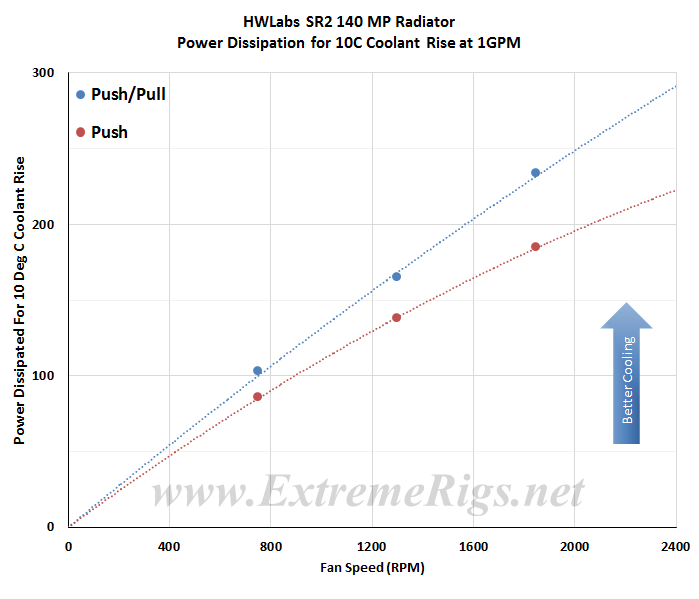 As we just saw, a push only fan installation is very efficient on this radiator. However because the core is very thick there is a decent boost from adding the second fan. At each fan speed adding a second fan (Push/Pull) yielded an average performance increase of ~18%.
As we just saw, a push only fan installation is very efficient on this radiator. However because the core is very thick there is a decent boost from adding the second fan. At each fan speed adding a second fan (Push/Pull) yielded an average performance increase of ~18%.
Now let’s analyze that data some more…








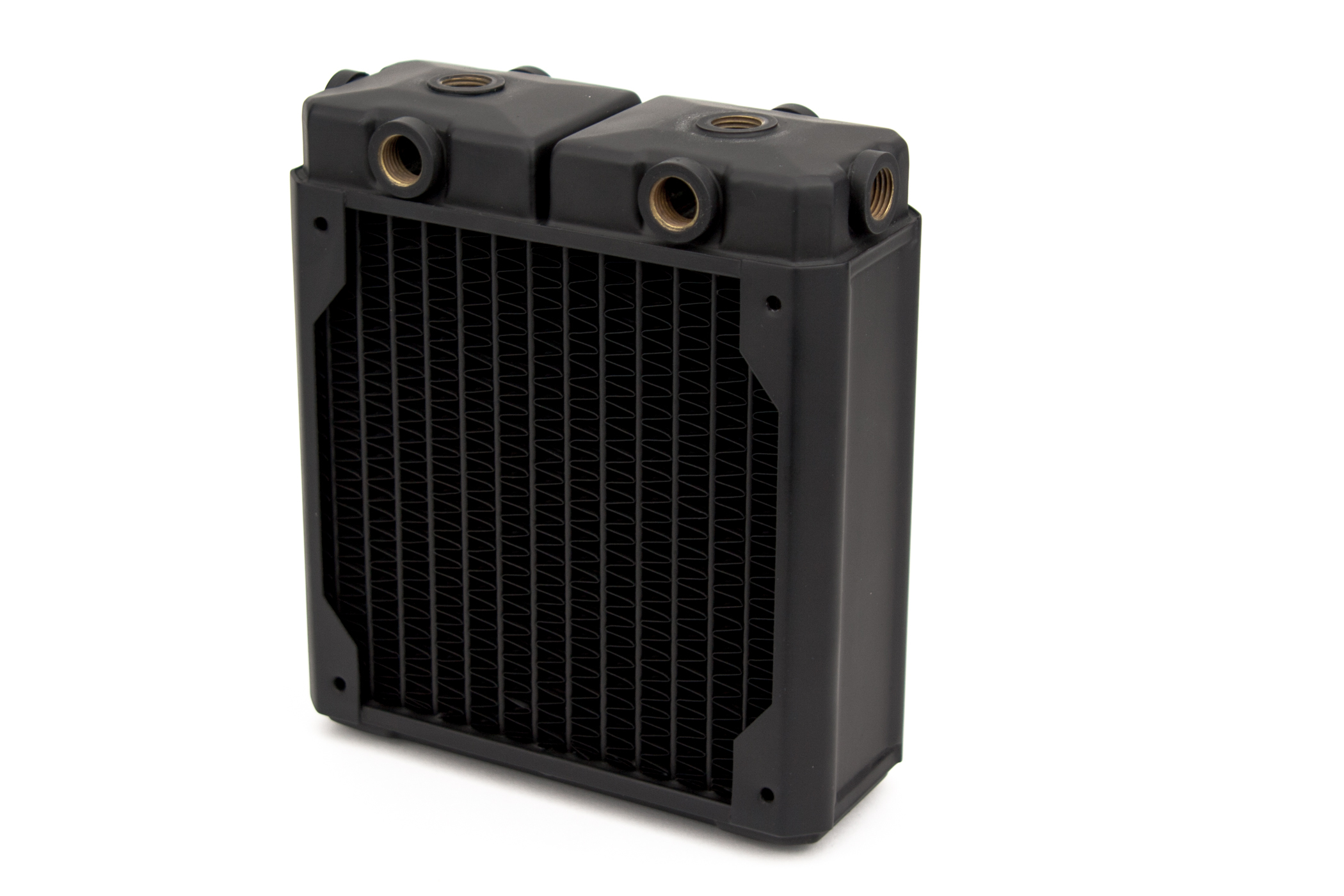



[…] let us down. After all we’ve already seen it perform well in our reviews for the SR2 140 MP and SR2 420 […]
Comments are closed.